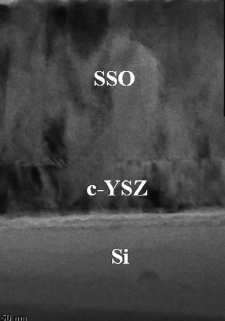New room-temperature magnetic semiconductor material holds promise for ‘spintronics’ data-storage devices
September 17, 2013

Cross-section transmission electron micrograph of strontium tin oxide thin film on silicon chip (credit: Y. F. Lee et al./APL)
“Spintronics” refers to technologies used in solid-state devices that take advantage of the inherent “spin” in electrons and their related magnetic momentum to store data.
The researchers synthesized the new compound, strontium tin oxide (Sr3SnO), as an epitaxial thin film on a silicon chip (Epitaxial means the material is a single crystal).
Sr3SnO is a dilute magnetic semiconductor, so it could be used to create transistors that operate at room temperature based on magnetic fields rather than electrical current.
“There are other materials that are dilute magnetic semiconductors, but researchers have struggled to integrate those materials on a silicon substrate, which is essential for their use in multifunctional, smart devices,” says Dr. Jay Narayan, John C. Fan Distinguished Professor of Materials Science and Engineering at NC State and senior author of a paper describing the work.
(¯`*• Global Source and/or more resources at http://goo.gl/zvSV7 │ www.Future-Observatory.blogspot.com and on LinkeIn Group's "Becoming Aware of the Futures" at http://goo.gl/8qKBbK │ @SciCzar │ Point of Contact: www.linkedin.com/in/AndresAgostini
 Washington
Washington